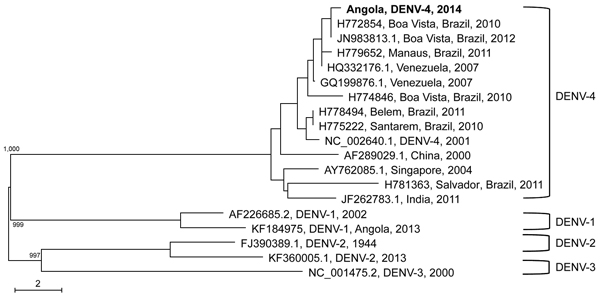Volume 20, Number 10—October 2014
Letter
Probable Importation of Dengue Virus Type 4 to Angola from Brazil
Figure

Figure. Phylogenetic analysis of a dengue virus (DENV) type 4 strain isolate (boldface) from a patient in Israel who apparently acquired DENV in Angola in 2014, showing close relationship with isolates from Brazil. The DENV isolate was aligned with representative DENV sequences from around the world, representing serotypes 1–4. Reference strains, downloaded from public databases (http://www.ncbi.nlm.nih.gov/nuccore), are identified by accession number, place, and year of isolation (DENV-4 isolates) or by serotype, accession number, and year of isolation (DENV-1–3 isolates). Specific branches indicate bootstrap values. Scale bar indicates percentage identity difference.
1These authors contributed equally to this article.
Page created: September 04, 2014
Page updated: September 04, 2014
Page reviewed: September 04, 2014
The conclusions, findings, and opinions expressed by authors contributing to this journal do not necessarily reflect the official position of the U.S. Department of Health and Human Services, the Public Health Service, the Centers for Disease Control and Prevention, or the authors' affiliated institutions. Use of trade names is for identification only and does not imply endorsement by any of the groups named above.